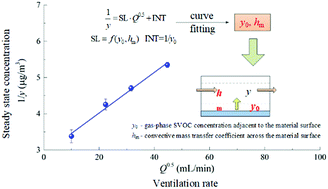Emissions of DEHP from vehicle cabin materials: parameter determination, impact factors and exposure analysis†
Abstract
Semi-volatile organic compounds (SVOCs) are widely used in materials employed in vehicle interiors, causing poor in-cabin air quality. The emission characteristics of SVOCs from vehicle cabin materials can be characterized by two key parameters: the gas-phase SVOC concentration adjacent to the material surface (y0) and the convective mass transfer coefficient across the material surface (hm). Accurate determination of y0 and hm is fundamental in investigating SVOC emission principles and health risks. Considering that the steady state SVOC concentration (y) in a ventilated chamber changes with the ventilation rate (Q), we developed a varied ventilation rate (VVR) method to simultaneously measure y0 and hm for typical vehicle cabin materials. Experimental results for di(2-ethylhexyl)phthalate (DEHP) emissions from test materials indicated that the VVR method has the merits of simple operation, short testing time, and high accuracy. We also examined the influence of temperature (T) on y0 and hm, and found that both y0 and hm increase with increasing temperature. A theoretical correlation between y0 and T was then derived, indicating that the logarithm of y0T is linearly related to 1/T. Analysis based on the data from this study and from the literature validates the effectiveness of the derived correlation. Moreover, preliminary exposure analysis was performed to assess the health risk of DEHP in a vehicular environment.

- This article is part of the themed collection: Indoor Air: Sources, Chemistry and Health Effects


 Please wait while we load your content...
Please wait while we load your content...